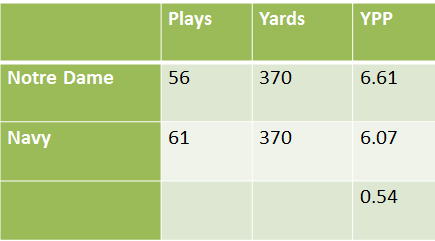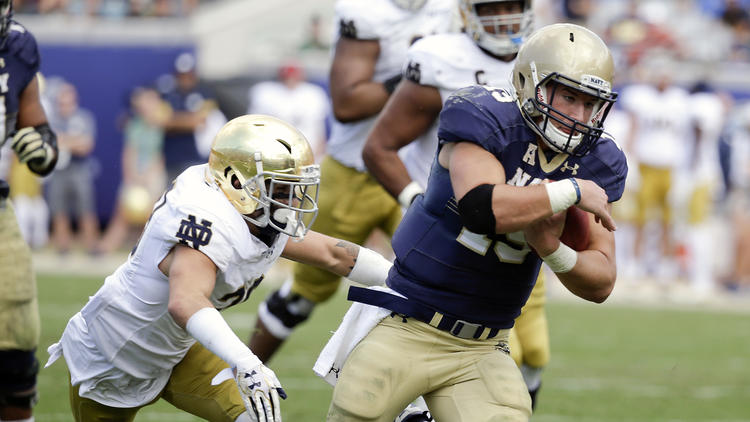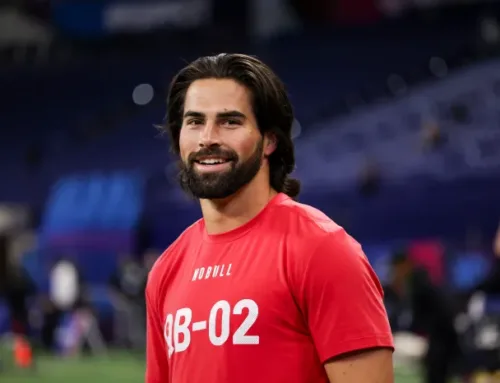The team with the better offense played more aggressively and won the game. That should be Notre Dame, but instead Will Worth and Navy executed their gameplan to perfection, while the Irish defense floundered. Settling for field goals has fans feeling like Jack Swarbrick is settling with Brian Kelly as head coach.
Confused? Check out the advanced-stats glossary here.
Explosiveness

Nothing about this game was surprising, if you take away the names on the jerseys and expectations associated with them.
Navy plays low-turnover games (they don’t turn it over or force many), is rarely penalized, and has a very good offense. They have a very bad defense, but play bend but don’t break and hope opponent drives will stall out from turnovers, penalties, or settling for field goals.
So while the way this loss unfolded was frustrating and disappointing, it was more confirmation about this 2016 Notre Dame team than anything else. The defense is better than it was under Brian Van Gorder, but is still bad and filled with young players that have been thrust into roles they shouldn’t have to fill. The offense is talented, but inconsistency leads to underperformance, and some missed throws and settling for field goals meant that they couldn’t keep pace with Navy in a game that everyone in Jacksonville knew would have very few possessions.
And this loss again featured poor in-game decisions and preparation from Brian Kelly and the Irish staff. It’s a team that has consistently looking unprepared (giving up surprise onside kicks that are recovered uncontested) and unorganized (12 men on the field multiple times, and in key situations). As he did in the Michigan State loss, Kelly chose to kick late in the game and trust a defense that had struggled all game, and never saw the offense get the ball again.

With the loss Notre Dame dropped to 1-6 in one possession games. It’s an indication that the Irish are better than their record, and it sure beats getting blown out, but it’s also an indictment. Smart football folks like Bill Connelly and Bill Barnwell have written that a sub .500 record in these kind of close games is usually a little bit of bad luck, but that good (or bad) performance can be sustained by quarterback play, special teams, and coaching. Each of those categories was overall an advantage for the Irish in 2015, and yet with the same faces in those key positions, they’ve been a huge weakness as a whole this season. That assessment is probably is a little harsh on DeShone Kizer, but for special teams and coaching it’s definitely well-deserved.
Efficiency

Less disheartening to me than Navy’s offense succeeding at doing Navy things (run for 3, run for 2, run for 3, convert 4th and 2) was the defense’s inability to capitalize on chances to put the Midshipmen off schedule. The 12 on the field penalty was brutal and bad officiating, but here’s the list of other scenarios the defense blew without much help from the refs in the 2nd half:
- 3rd Quarter, 3rd and 9: 37-yard TD run
- 3rd Quarter, 3rd and 9: 10-yard pass
- 3rd Quarter, 3rd and 7: 27-yard run
- 4th Quarter, 3rd and 9: Pass Interference
- 4th Quarter, 3rd and 7: 6-yard run (Navy converts 4th and 1)
- 4th Quarter, 4th and 6: 15-yard pass seals Navy win

I really worry about the offense for the remainder of the season. How would you even describe the Notre Dame offensive identity right now? A spread that leans towards the pass but is inconsistent, is mediocre running the ball, and doesn’t utilize tempo? What’s most frustrating is that it seems like the offense often finds mismatches that work – like linebackers matched up against slot receivers in pass coverage – and finds early success only to quickly abandon those ideas.
By current Defensive S&P+ rankings, the Irish have the #11 (Virginia Tech), #23 (USC), and #44 (Army) defenses left. Are there any wrinkles left to explore? Ways to get DeShone Kizer more comfortable in the pocket, or run the ball more consistently?
Field Position
Average Starting Field Position:
Notre Dame: Irish 26
Navy: Midshipmen 25
Field position ended up being pretty inconsequential in a game featuring a lack of special teams plays and punts. Nine of 12 meaningful possessions ended in a score, and it would have been 10 if Navy hadn’t kneeled out the clock.
Neither defense had much hope of stopping the other offense – it really came down to which offense stubbed its toe first or settled for more conservative decisions. Which leads us to…
Finishing Scoring Drives

With the Navy offense chewing up clock, Notre Dame had only six offensive possessions in the game. But the Midshipmen had the same number if you take out the drive that began with around 30 seconds left before halftime, where Coach Ken was not really given much of an opportunity to score. The Middies scored touchdowns on all of their possessions that entered the red zone and Irish 40-yard line, and likely would have a perfect 7.0 point average if they hadn’t run out the clock of the final drive.
And it’s this table that makes Brian Kelly’s late-game decision making so frustrating. At that time Navy had been stopped once and their average drive had been 9.6 plays, 67.4 yards, over 5 minutes time of possession, and 5.6 points. Kelly argued that the defense should have been able to force a stop, and that with a touchdown you’re still only down a score and a two point conversion. But he had watched the same defense fail to get off the field all day, with a nine-minute drive just a possession ago.
Turnovers
Zero – the same amount of excitement I have for the remainder of the season right now. So here’s the ICON from Miami, to remind us that this also sucks for the players trying their damndest to win these games. They haven’t quit, and are still worth our time, energy, and support, as dark as things may be.





Michael,
Thanks very, very much for that last comment. Completely true.
And also thanks for a very tight, well-written, and illuminating piece.